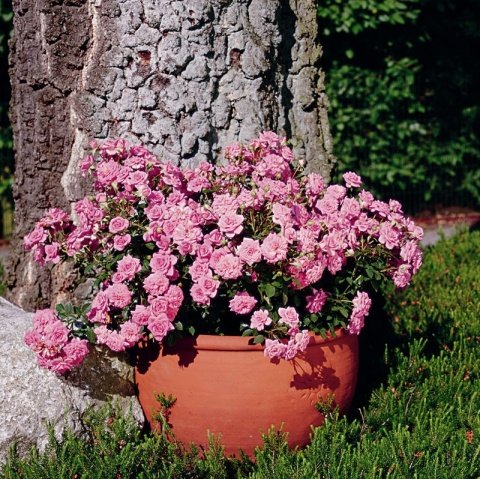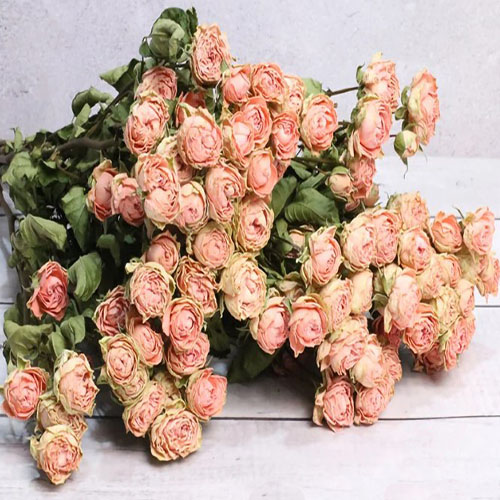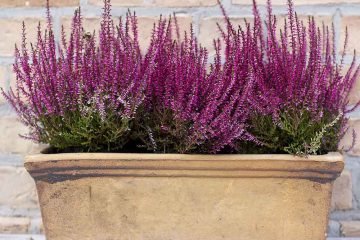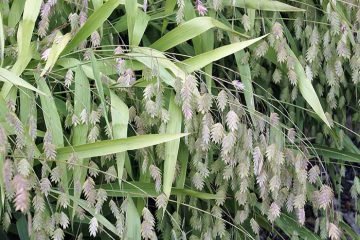miniature rose
Miniature rose specifications
- Common Name : Miniature rose, rose
- Botanical Name : Rosa spp.
- Family : Rosaceae
- Plant Type : Deciduous shrub
- Sun Exposure : Full sun
- Soil Type : Moist but well-drained
- Soil pH : Neutral to acidic
- Bloom Time : Late spring, summer
- Flower Color : Pink, red, yellow, white
- Native : northern and southwestern Chinese hemispheres of Guizhou, Hubei, and the provinces of Sichuan and Japan
Miniature roses are true roses that have been selectively bred to stay small in size. Most miniature roses have smaller flowers than standard rose bushes, but they come in the same variety of types and colors as their larger counterparts. Despite their petite size, miniature roses are extremely hardy. They are more winter-hardy than most roses and tend to be profuse repeat bloomers, making them easy-growing roses.
Miniature roses grow moderately quickly and work well in a border or as garden edging. They’re also especially nice as specimen plants in containers, either planted inside or outside, where they can be brought closer to eye level and truly be seen and appreciated. They grow best when planted in spring, and since they propagate on their own roots, you can enjoy their blooms year after year. dried miniature rose

read more : Everything about hydrangeas : How to Plant & care for Hydrangea
Types of Miniature Roses
Like types of full-sized roses, miniature roses come in hundreds of varietals. Primarily, they fall into the following categories :
- Climbers : Miniature roses with a vertical rambling growth habit that can be trained to grow against supports are known as climbing roses. The only thing ” miniature ” about these roses is the size of their flowers. In fact, the award-winning ‘ Jeanne Lajoie ‘ varietal doesn’t appear mini at all—if grown properly, it can reach heights of more than 7 feet. Similarly, the ‘Snowfall’ varietal is a white ever-bloomer with canes that stretch between 7 and 12 feet.
- Trailers : Miniature roses with a cascading growth habit are known as trailers, and can be wonderful in baskets and draping over walls. The ‘ Sequoia Gold ‘ varietal, one of the best fragrant rose varieties , has double flower blossoms that repeat all season , while the ‘ Green Ice ‘ varietal is a hardy plant with unusual blooms that start out apricot , open to double white flowers , and age to a cool , light green. dried miniature rose
- Micro-mini : This varietal is the smallest of the miniature roses, growing only 6 to 12 inches tall, with proportional tiny blossoms that are up to 1 inch in size. ‘Bambino’ has vibrant orange blossoms on an 8 to 12-inch plant, while ‘Chasin’ Rainbows’ has yellow flowers that are edged in scarlet.
Miniature Rose Care
Here are the main care requirements for growing miniature roses :
- Plant miniature roses in the spring using rich, well-drained soil, and top with a layer of mulch.
Miniature roses thrive in full sun, with at least six to eight hours of daily sunlight. - They can be planted in nutrient-rich garden soil, or if planting in patio containers, buy bags of lightweight potting soil.
- Watering needs will vary depending on your soil and weather, but in general, provide your miniature roses with 1 inch of water per week.
- Prefers moderate temperatures around 70 degrees Fahrenheit; cannot withstand cold temperatures below 32 degrees Fahrenheit. dried miniature rose
- Require regular fertilizing with any commercial rose food or general all-purpose fertilizer.
read more : Everything about fern plant : How to Plant & care for them
Planting
Like full-size roses, the miniature variety does best if planted in the spring. Wherever you’re planting them, first carefully remove the rose plant from the pot and gently loosen its roots. If the plant’s roots are tightly bound, use a sharp knife to score the sides of the root ball and try to loosen the roots.
- Plant Mini Roses Indoors : Place the rose bush in the center of the partially filled pot, topping with soil and gently patting it down. Set in a location that receives six to eight hours of sun a day.
- Plant Mini Roses Outdoors in Pots : When growing roses in pots, fill the pot about two-thirds full of prepared soil mix. Place the rose in the pot, then fill around the plant with the remaining potting soil, pressing it down firmly around the roots.
- Plant Mini Roses in the Garden : Dig a hole the same height as the pot the miniature roses came and about a foot wider. Add mulch to protect the roots from the cold, as well as aid in moisture retention.
 Light
Light
Like all roses, the miniature varietals thrive in full sun. Though they can tolerate a bit of shade, often times their foliage and flowers will become sparse in shady conditions. At least six to eight hours daily of sunlight should result in the best disease resistance and the most full, bloom-packed bush possible.
 Soil
Soil
Roses like rich, well-drained, and loamy soil. Miniature roses are also a favorite plant for patio containers. If you choose to go this route, don’t dig up soil from the garden to use to grow your pot of roses. Instead, buy bags of potting soil—garden soil is too heavy and can compact with the frequent waterings needed for container plants, potentially suffocating the roots. Light, nutrient-rich potting soil drains well, helping the plant avoid root rot. dried miniature rose
 Water
Water
Miniature roses typically require about 1 inch of water per week, but watering needs for specific plants may vary based on the soil and weather in different growing locations. This could mean daily waterings, every other day, or even just twice a week. dried miniature rose
Be sure to water deeply to promote good root development and aim your hose at the base of the plant to avoid spraying the delicate blooms directly. Due to their smaller roots, miniature roses may require more frequent watering during extreme heat when compared to their full-sized cousins.
read more : Everything about bamboo : How to Plant & care for them
 Temperature and Humidity
Temperature and Humidity
Miniature roses can withstand a moderate range of temperatures but will do best around 70 degrees Fahrenheit. They cannot withstand cold temperatures below 32 degrees Fahrenheit, so if you’re expecting a drop, your best bet is to bring any bushes planted in containers indoors.
Although mini roses do quite well in containers, and you often see them sold as houseplants, many gardeners are disappointed by their performance indoors. Like traditional roses, they need full sunlight and medium humidity. To successfully grow them indoors, supplemental light and humidity are required.2
 Fertilizer
Fertilizer
Roses can be heavy feeders and since miniature roses continue blooming all season, regular fertilizing is essential. Use any commercial rose food or general all-purpose fertilizer, applied according to label instructions.
To keep your plant healthy, feed it when the bush first leafs out and again after each heavy flush of blooms. Cease feeding your roses about six to eight weeks before the first expected frost to discourage new growth that could be killed back during winter.
Pruning Miniature Roses
As with other roses, you’ll want to prune miniature roses just before their new growth starts in late winter or early spring. Hard pruning is not necessary—simply prune dead or broken wood first, then trim back about one-third of the plant to maintain its shape and encourage new growth. dried miniature rose
read more : Everything about Eucalyptus plant : How to Plant & care for them
Overwintering Miniature Roses
Preparing your miniature rose bushes properly for winter is important, though how your specific bush reacts to colder weather can depend on several factors, including the age of the plant, your hardiness zone, and more. In general, miniature roses will stop blooming once the temperatures sustain below 50 degrees Fahrenheit, and they cannot withstand cold temperatures below 32 degrees Fahrenheit. Winterizing your plants will help protect them against too much damage, ensuring that a heavy frost or deep freeze doesn’t kill off your bush for good.
One of the most popular ( and easiest ) methods of overwintering any type of rose bush is called collaring. To utilize this method, begin by removing all the leaves ( but not the hips ) from the rose bush. Tie the bush up with twine and surround the bush with a wire hoop to form a “collar.”
Fill the collar with drive leaves ( like ones that have fallen from trees in your yard ) to help insulate the branches, wrapping the entire bush with a layer of burlap if you’d like to as well. Cover the root zone and crown of the plant with additional soil, mulch, or straw to insulate the roots and protect them from heavy snow or ice. dried miniature rose
While ground-planted miniature roses can be winterized, if your miniature roses are planted in containers, they must be moved indoors. Ideally your potted roses could live in an unheated garage that keeps around 40 degrees to allow the plant to go dormant. Do this before winter’s first freeze to give your plant the best shot at surviving the coldest months of the year.
Iran dried miniature rose
Due to the high quality of Iranian flower and plant products, the order and sale of dried flowers and flowers has grown significantly. Miniature roses are also on the list of these orders as a widely used natural flower. Because of the low cost of miniature roses, it has attracted a lot of public attention. This public outcry has boosted the mass production and direct supply of miniature roses.
Major and high quality products have themselves become the basis for sales and competition in global markets. So that the Iranian rose has achieved its rightful place due to its high potential, especially in neighboring countries. As today, the export of natural roses in all its species is booming.

Active flower and plant productions in Iran produce different types of roses and offer them to the market with the best quality in order to reach the consumer. dried miniature rose
The production of these flowers, in addition to meeting domestic needs, has caused exporters to supply miniature roses for export for export to other countries with high quality. In our country, the sale and export of roses , especially to the UAE and other neighboring countries, is mainly done. Because Iran is the fifth largest exporter of flowers in the Middle East and the 17th largest exporter of flowers in the world.
Since roses are widely used in the perfume, pharmaceutical and food industries, it has led to the purchase and sale of miniature roses in bulk and in retail with modern and stylish packaging in domestic and foreign markets.
read more : Drying natural flowers | Introducing 8 wonderful ways to dry flowers
Common Pests and Diseases
Unfortunately, miniature roses are subject to the same problems as larger roses, including black spot, a fungal disease. Powdery mildew can also be an issue. To avoid both of these inflictions, improve the air circulation around your roses by planting each bush a few feet apart and watering the plant from the base of the roots instead of overhead.
As with other roses, systemic rose-care products can also help prevent diseases and discourage pests. Always remove diseased debris and dispose of it to prevent reinfection, and keep an eye out for early signs of insect damage ( Japanese beetles, thrips, mites, or chafers ). Treat any sign of infection swiftly with an insecticide.
How to Get Miniature Roses to Bloom
Like their full-sized counterparts, preparing for rose blooms of the miniature variety begins in mid-spring, with their blooming period continuing through early fall ( though some will bloom year-round with the proper conditions ). To bloom, roses must have at least six hours of sunlight daily, as well as regular feedings ( a soil mixture high in organic nutrients is also an added bonus ).
If you have a continually blooming varietal ( like ‘Fairy Moss’ and ‘Lemon Drift ), you can coax repeat blooms by deadheading any faded blooms before they go to hip. Preventing hips from forming will keep the plant from entering dormancy, which can be signaled by seed production.
How to Get Miniature Roses to Bloom
To set your miniature roses up for success, be sure to plant them in an area where they’ll receive six to eight hours of sunlight a day. Use well-draining, loamy soil and fertilize your miniature roses monthly during the growing season of early spring to fall. dried miniature rose
If the conditions are right, you’ll be rewarded with colorful, lightly fragrant blooms from mid-spring to early fall, with miniature roses that bloom continuously for two to weeks.
read more : Everything about protea flowers : How to Plant & care for them
Bloom Months
Miniature roses typically bloom from mid-spring through early fall, often between April and September.
How Long Do Miniature Roses Bloom?
Typically, miniature roses bloom continuously for two to three weeks. Since miniature roses are perennials, they will rebloom every year with proper care. Plenty of sun paired with frequent fertilizing and deadheading will encourage the blooms to last longer. dried miniature rose
What Do Miniature Roses Flowers Look and Smell Like?
Like their name suggests, miniature roses are a smaller (yet just as fragrant) version of their full-sized cousins. With a light, lovely scent, miniature roses come in a variety of colors, including pink, red, yellow, and white. Miniature roses grow to a height of 1 to 3 feet, and a width up to 2 feet.
How to Encourage More Blooms
To promote new blooms during the growing season, remove flowers as they fade. Same goes for any yellow leaves or dead growth.
Caring for Miniature Roses After They Bloom
Prune your miniature roses in late winter or early spring, before new blooms appear, trimming back about one-third of the plant. This will maintain its shape and encourage growth.
read more : Everything about Amaranth flowers : How to Plant & care for them
Deadheading Miniature Roses Flowers
Deadheading, or removing the faded flowers, once a week will promote new growth and additional blooms. Cut off the finished flower just below where the base of the flower joins the stem.
Common Problems With Miniature Roses
While relatively easy to care for, miniature roses are susceptible to the same issues full-sizes roses are. Beware of these common problems.
-
Black Spot
Black spot on your roses indicate a fungal disease. Warm, wet, or humid weather plays a big part in its development. If you see evidence of black spot, spraying with Bordeaux Mix, neem oil, or sulfur is effective. Then make sure your miniature rose bushes receive full sun, with plenty of water and good air circulation.
-
Japanese Beetles
Japanese beetles feed on many different plants, but are particularly attracted to rose bushes. If congregated in large numbers, they can cause a great deal of damage quickly by feeding on the leaves. There’s no easy way to get rid of Japanese beetles, but hand-picking and dropping them into a bucket of soapy water is the best (although tedious) method.
-
Buds Won’t Bloom
Are your miniature roses getting six to eight hours of direct sunlight a day? If not, it isn’t getting enough sun, so the buds may not bloom properly.
read more : Everything about Aster flowers : How to Plant & care for them
FAQ
-
Do mini roses come back every year ?
Yes, miniature roses are hardy perennials that will come back year after year to treat you to vivid, beautiful blooms.
-
Can you leave miniature roses outside in the winter ?
Miniature roses left outside in the winter will naturally start to enter a period of dormancy once the temperatures dip below freezing. However, it’s best to winterize your miniature roses (using a technique like collaring) to protect against too much damage.
-
What’s the difference between roses and miniature roses ?
Miniature roses and full-sized roses are virtually exactly the same, save the size of their buds. In fact, many popular miniature rose varietals are hybridized from full-sized counterparts.
-
Are miniature roses easy to care for ?
Caring for roses is a passion for many, and miniature roses are tended to in the exact same way as full-sized roses. As long as you provide them with plenty of sunlight and food, as well as maintain periodic pruning, miniature roses are easy to care for.



0 Comments